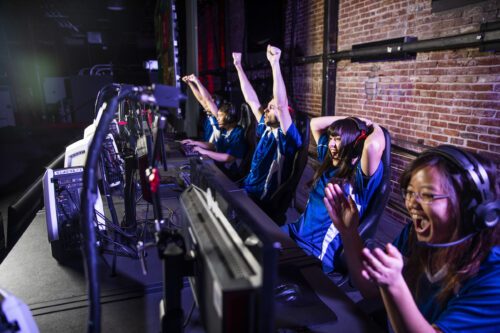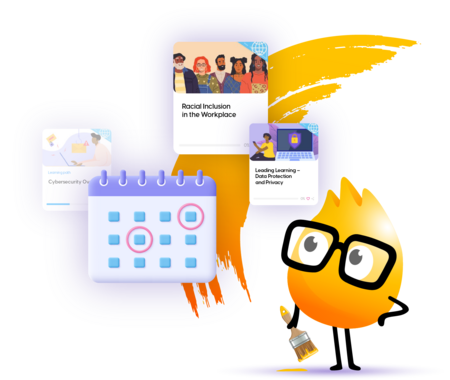Why Gamification is a Natural Fit for Sales Training
Salespeople are notoriously tough. They have to be: it’s their job to hunt down prospects who will buy from them.
They endure a lot of rejection along the way, and some sales compensation models still mean that a salesperson’s salary is dependent on their sales commission, meaning reps have to make sales to make money.
The very best salespeople are strong-willed and thick-skinned. They make their quota every quarter; they go after the prospects they know will buy; and they don’t much care what people think of them. They are competitive, and that can be amazing for a sales manager when it comes to making sales targets.
It can be less than amazing, however, if you’re trying to get your sales superstars to do something they don’t want to do like take training — then that strong will is turned on you.
Fortunately there is a way to harness your sales reps competitive majors and get them to take training: gamification.
What is gamification?

Sales reps take training modules, earn points and are either awarded a badge, or appear on a leaderboard that ranks all reps by their training activity. Think of Harry Potter’s House Cup – when Harry does something praiseworthy, he’s awarded points for all of Hogwarts to see.
Gamification isn’t new. Originally coining in 2002 by programmer Nick Pelling, the term gamification became a buzzword a decade ago when companies began using it for marketing purposes, adding game elements to their products and websites to attract and retain customers.
Gamification was picking up speed in 2012 when Gartner released its report about the future of gamification. Among its predictions: gamification would be a widespread part of training and education by 2020. Gamification would be used to make learning more engaging.
Although the hype of 2011 and 2012 has faded, gamification is still growing and changing. The global gamification market is projected to grow by 30 percent between now and 2024.
Currently, gamification is being used as a tool to combat disengagement at work. A study published by researchers Michael Sailer, Jan Hense, Heinz Mandl and Markus Klevers in the Interaction Design and Architecture Journal found that gamification increases motivation by meeting the needs of different kinds of learners. They list three of the most common trait-based motivations:
- Achievement: Learners with a strong achievement motive respond well if gamification emphasizes achievement, success and progress.
- Power: Players are motivated when gamification emphasizes status, control and competition.
- Affiliation: These players are motivated when gamification places emphasis on teamwork and membership of a group
Why gamification is a natural fit for sales training
For the most part, salespeople tend to fall into the power motivation class mentioned above.
Gamifying training that emphasizes competition is a way to keep them engaged with your training content while indulging their competitive streaks.
How might that work? Let’s take a look at the three main game mechanics used most often used by gamified learning, points, badges, and leaderboards.
Points
Learning management systems (LMS) often use points the way you’d use them in a video game. A sales rep might earn points for different learning activities, such as answering correctly on a quiz, or for taking a learning module. They might even earn additional points for logging on to the LMS for a certain number of days in a row, a mechanism used by some social games like Pokémon Go to keep players coming back.
Badges
Badges indicate mastery. If a salesperson has taken all the training associated with a new product line, and passed every quiz with flying colors, they might earn a badge. Or, if they’ve demonstrated that they know how to overcome specific objections, they might earn a badge. Once earned, those badges are displayed on the rep’s profile in the LMS, and maybe even in the sales CRM (customer relationship management) software.
Leaderboards
If you’re old enough (or if you watch Stranger Things) you’ve seen the old arcade games that displayed a list of the top players with the top scores between games. That’s a leaderboard. In training, your leaderboards will list the top point-getters on your sales team, showing who’s got the most points, and maybe even displaying each rep’s badges. Publicly visible leaderboards fulfill a need for recognition in reps and can spark competition, especially between top performers.
Gamifying your sales training
There are several ways to gamify sales training.
Intra-team competition: You can use points and public leaderboard (displayed on your LMS or CRM) to encourage your reps to compete with one another. If recognition by team members and management isn’t enough for your reps, you can sweeten the deal by offering incentives to the “winner,” like a cash bonus or a prize.
Self-competition: Using badges to encourage mastery, you can encourage reps to take a specific learning path, beating their own bests, and earning incentives like recognition or prizes when they reach certain levels of mastery.
Inter-team competition: Remember the Harry Potter House Cup reference? Hogwarts uses an inter-team gamified set-up to get kids to behave and work together. This can work for you as well, if you manage multiple sales teams; each team works together to outlearn the other. The team that takes the most learning wins. Don’t have more than one sales team? No worries. Work with your director of learning and development and other department heads to set up a competition with another department, like marketing, for example. This approach works well to encourage teamwork among salespeople, which isn’t always easy.
Keeping competition friendly
Although points and leaderboards can be a powerful tool, sales managers have to be careful in how they use them.
For example, leaderboards tend to make the top point-getters extremely competitive. Those at the bottom may become discouraged by how far behind everyone else they are and stop trying. By using a public leaderboard, you might encourage your top performers, but discourage everyone else.
Instead, you might consider keeping the lower rungs of the leaderboard private and doling out rewards to top performers without identifying the lowest achievers.
You also don’t want the competition to turn toxic. A friendly competition can quickly turn ugly when highly competitive people on the same team compete against each other for leads.
Remember: If you’re encouraging competition against one another, you’re a part of the game too. Commit to being fair. Make sure you recognize and reward all those who deserve it and admit it if you’ve accidentally overlooked someone’s accomplishments. After all, if it looks like the game is rigged, or someone feels overlooked, people are not going to want to play anymore.
Your goal is to make sure everyone is learning and have a little fun while doing so.





